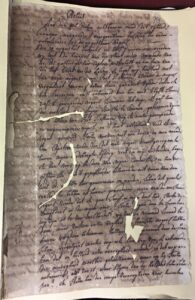What Did Resistance Leader Tula Really Say During the Largest Slave Rebellion in Curaçao?
The only record of Tula’s own words is currently on display at the National Archive in The Hague, and it is available for viewing this weekend only.
This document is so fragile that, as an exception, it will be shown on Saturday, October 15 and Sunday, October 16, 2022, as part of the exhibition Kòrsou Curaçao – Voices of the Past, People of Today. The account is exceptional—there is no other document that directly quotes Tula—and therefore holds significant historical value.
Normally, Tula’s account is stored in the archives of the National Archive in The Hague, kept in the dark, with controlled temperature and humidity levels. The cooler and drier the documents are stored, the longer they can last.
“Any small vibration could damage the document,” says guest curator Dyonna Benett, who keeps her hands behind her back as the box with the manuscript is carefully placed on the table. She is hesitant to approach it too closely. “No, no. Because even the smallest vibration could harm the document.”
The document dates back to 1795, the year of the largest slave rebellion in the history of the Dutch Caribbean islands.
Pater Ja cobus Schinck records a conversation he had with Tula during the rebellion. The resistance leader explains why he, along with hundreds of supporters, rose up and what he hoped to achieve.
cobus Schinck records a conversation he had with Tula during the rebellion. The resistance leader explains why he, along with hundreds of supporters, rose up and what he hoped to achieve.
“Everything is described in detail: the police interrogations, how Tula responded, his conviction, how he stood firm, his death,” says Benett. “A trial, down to the finest details.”
As an exception, the document is being shown to the public. Benett believes everyone should see it. “Because this is the tangible evidence of Tula’s trial process.”
After the weekend, it will be returned to the archives. “So it stays preserved for the next generation.”
Watch the fragment here:

